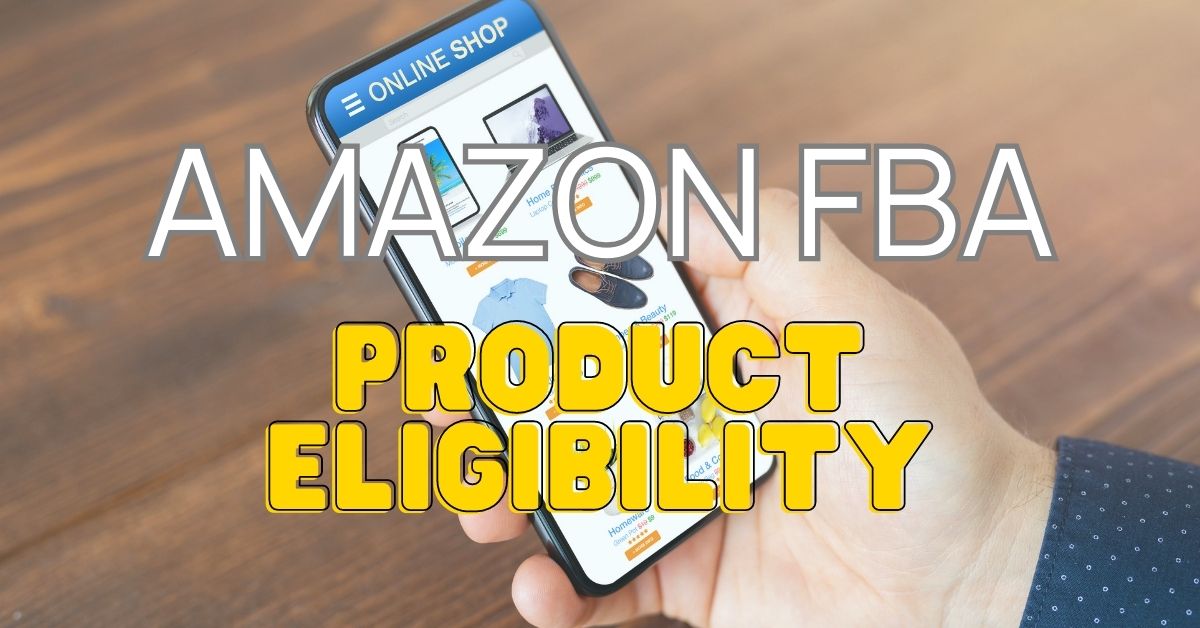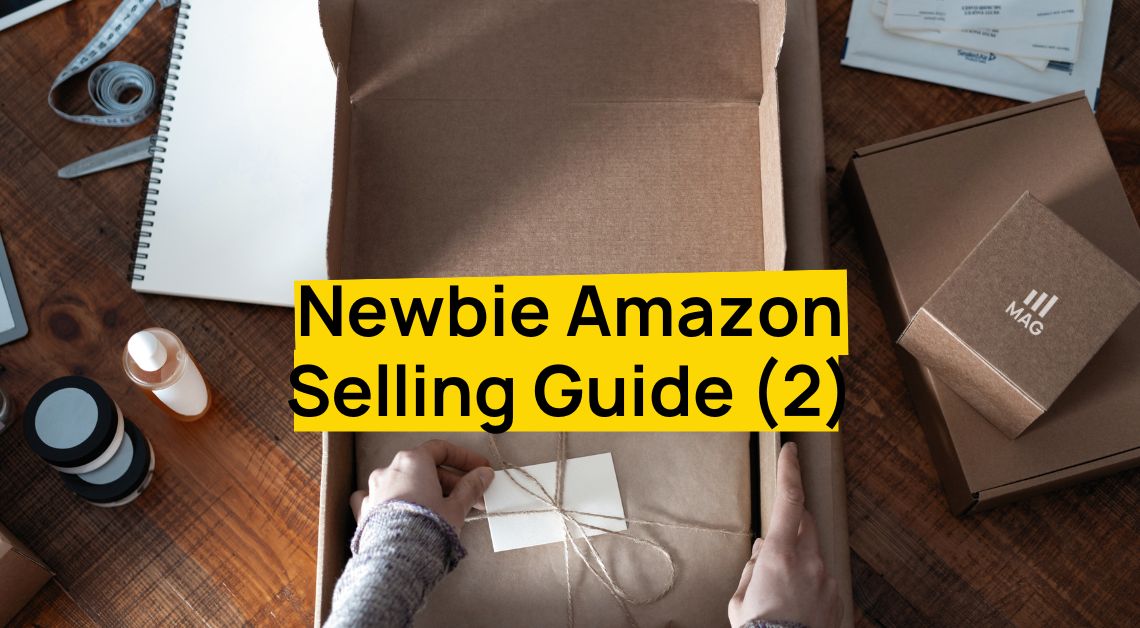Stop flailing around and sell stuff with effective Amazon Marketing tactics. Here is a step-by-step guide to building your Amazon marketing strategy in 2024.
Alright, Sellers, Here’s the Problem: You’ve got a fantastic product, but with 600+ million on Amazon, you need a smart strategy to make it shine. Without a strategic approach, your listings get lost in the shuffle.
Without a solid marketing strategy, you’re gambling with your business. Wishing for sales won’t cut it. A solid game plan will help you stand out and drive those conversions.
After reading this article, you’ll learn how to build a rock-solid Amazon marketing strategy that will get you noticed, increase your sales, and leave your competitors in the dust.
Develop Your Branding
Why do you need your own branding?
- Establish Credibility – to build trust with your target audience by showcasing a professional brand image of your Amazon Store
- Differentiation – to stand out from the competition by establishing a unique brand identity
- Brand Recognition – to foster brand recognition through consistent branding across all marketing channels
- Increased Customer Loyalty – to build a loyal customer base by creating an emotional connection through branding
Understand Your Long-Term Goals
- Define where you want your business to be in the future.
- Set clear, achievable objectives to guide your branding efforts.
Identify Strengths and Weaknesses
- Assess what your business does well and where it can improve.
- Leverage strengths to differentiate your brand.
- Address weaknesses to ensure consistent brand messaging.
Determine Your Unique Selling Proposition (USP)
- Pinpoint what makes your business unique.
- Highlight features or benefits that set you apart from competitors.
Create a Distinct Brand Identity
- Logo: Design a unique and recognizable logo.
- Colors: Choose a color palette that represents your brand’s personality.
- Fonts: Select fonts that are consistent with your brand’s image.
- Messaging: Craft clear and compelling messages that resonate with your audience.
- Tone of Voice: Maintain a consistent tone in all communications.
- Brand Values: Define and communicate your core values.
Implement Branding Across All Marketing Channels
- Apply your brand elements consistently on Amazon product listings, social media, and your website.
- Ensure your packaging, customer service, and promotional materials reflect your brand identity.
Foster Brand Recognition
- Use consistent branding to make your business easily identifiable.
- Reinforce your brand through repetition and visibility.
Establish Credibility & Trust
- Deliver on your brand promises to build a reputation for reliability.
- Engage with customers authentically to foster loyalty and trust.
Strong branding builds trust, increases sales & helps you stands out. Feeling overwhelmed?
Our Brand Guidelines service crafts your Amazon brand identity – USP, voice, story & visuals – for success. Get started today!
Identify & Understand Your Target Audience
Knowing your ideal customer unlocks three benefits:
- Laser-Focused Marketing: Reach the people most likely to buy, not wasting resources on those who aren’t interested.
- Happier Customers: Speak their language and address their needs, leading to greater satisfaction.
- Smarter Spending: Target the right audience with the right message, maximizing your marketing impact.
Conduct Research
- Demographics: Gather data on age, gender, income level, education, and location.
- Psychographics: Understand your audience’s interests, values, lifestyle, and personality traits.
- Behaviors: Analyze purchasing habits, brand interactions, and product usage.
Analyze Data
- Identify patterns and trends in the collected data.
- Use tools like surveys, social media insights, and market reports to deepen your understanding.
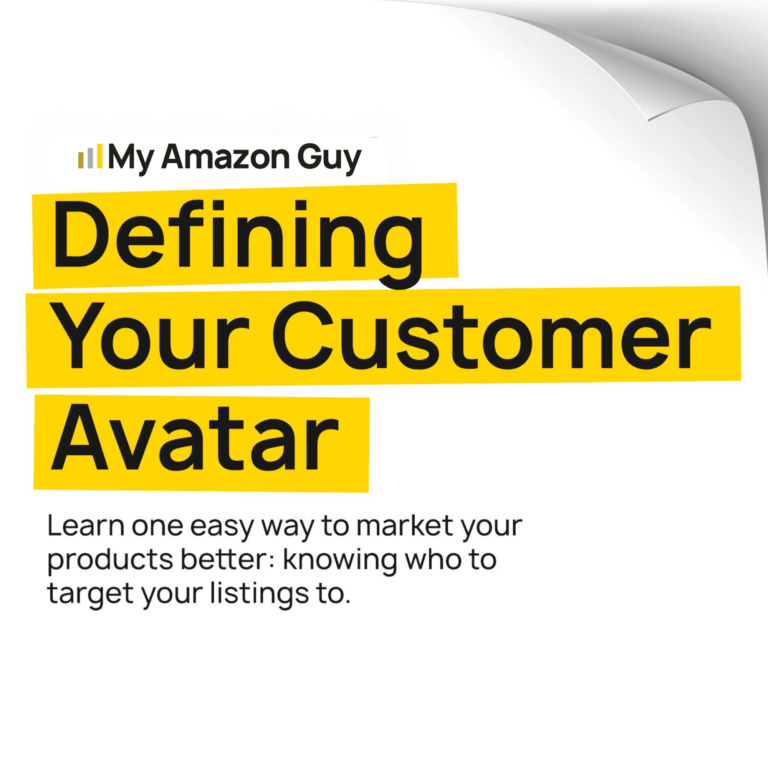

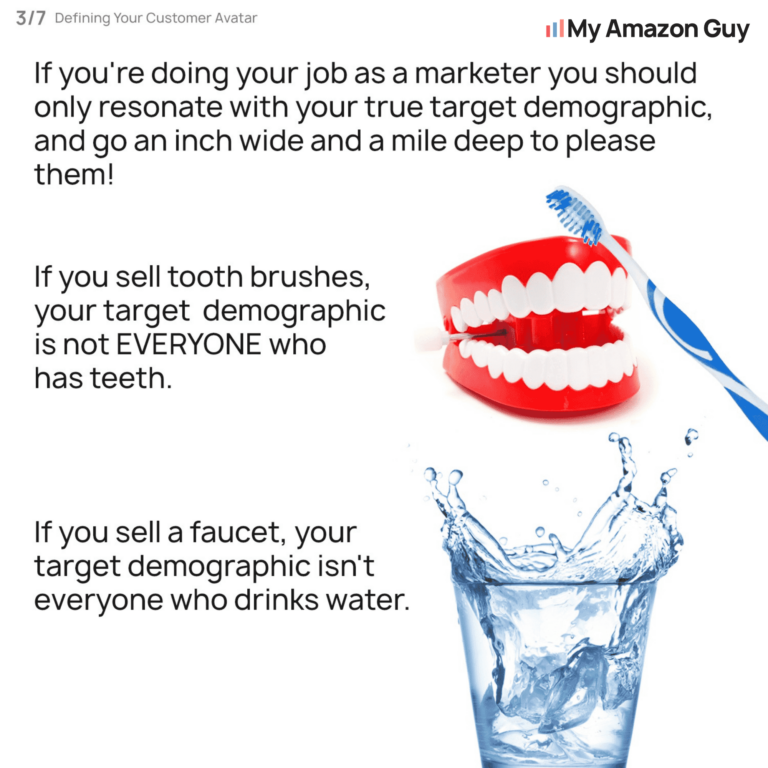
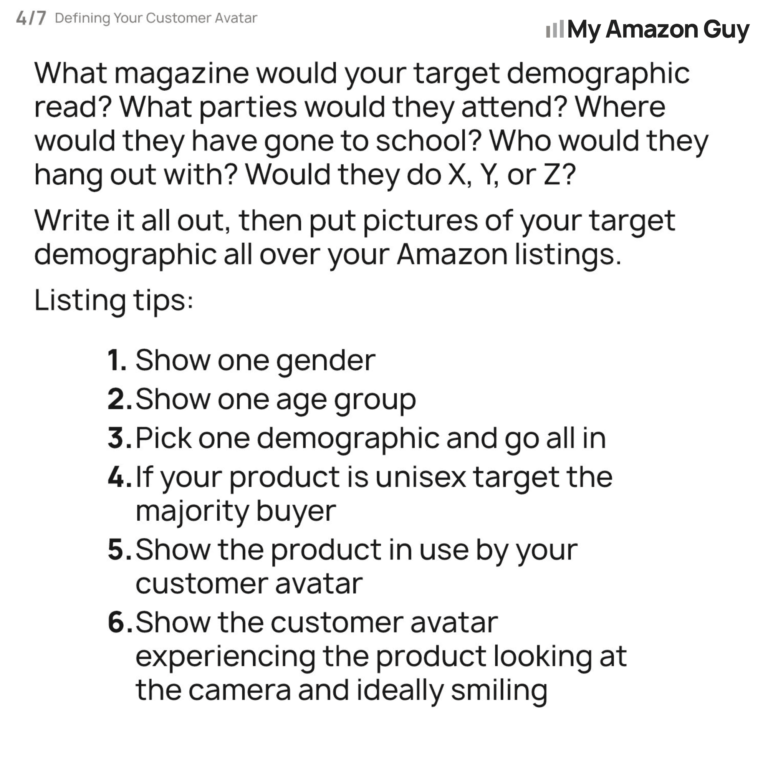
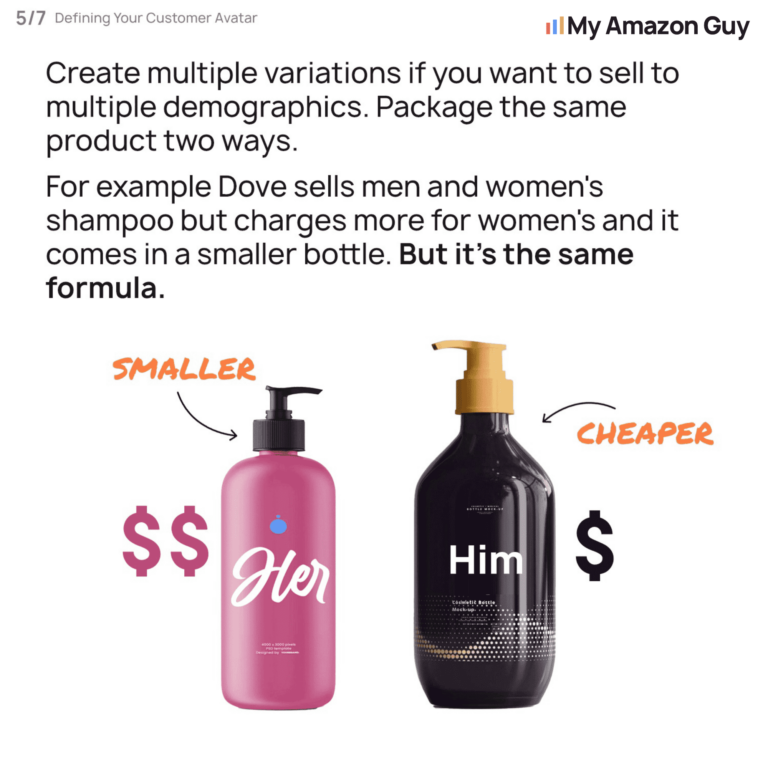
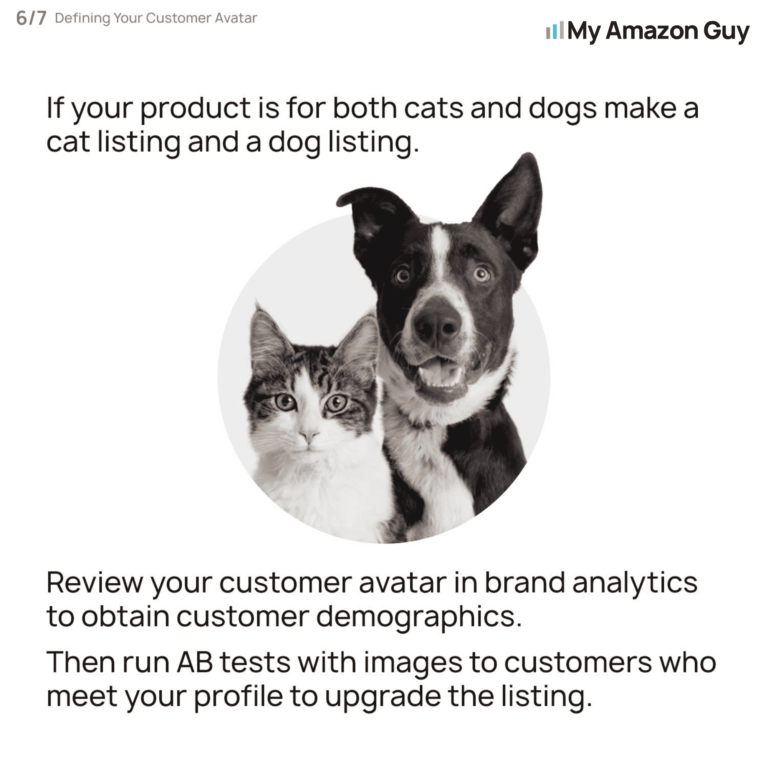

Create Customer Avatar
To create your customer avatar:
- Start with your product and target audience (initial guess).
- Look at sales data and real-world observations to see who actually buys your product.
- Focus on the benefits your product offers and tailor your avatar to someone who would use it.
- The level of detail can vary depending on how specific your product is.
Segment Your Audience
- Divide your target market into smaller, more manageable segments.
- Group customers with similar characteristics and needs.
Utilize Targeted Advertising
- Use Amazon’s advertising tools to reach specific segments of your target audience.
- Create targeted ad campaigns that speak directly to the needs and interests of each segment.
Customize Marketing Efforts
- Align with Needs: Tailor your marketing messages to address the specific needs and pain points of each segment.
- Preferences: Adapt your marketing strategies to match the preferences of your target audience.
- Pain Points: Provide solutions that directly address the common challenges your audience faces.
Craft Your Value Proposition
A strong value proposition is your secret weapon to winning customers. It does three things:
- Makes You Stand Out: Clearly shows why your product is different from the rest.
- Highlights the Good Stuff: Explains the benefits that matter most to your customers.
- Convinces Them to Choose You: Shows them why your product is the best solution for their needs.
Define the Specific Need
- Identify the primary problem your product solves.
- Understand what your target audience is looking for in a solution.
Highlight Additional Benefits
- List the key features that make your product stand out.
- Emphasize unique benefits that address secondary needs or enhance the primary solution.
Compare with Competitors
- Analyze similar products on the market.
- Identify gaps or shortcomings in competitor offerings.
Formulate the Value Proposition
- Clearly state why customers should choose your product (features and benefits).
- se language that resonates with your target audience.
Test and Refine
- Gather feedback from customers and adjust your value proposition as needed.
- Ensure it remains clear, concise, and compelling.
Communicate Consistently
- Integrate your value proposition into all marketing materials.
- Ensure consistency across product listings, ads, and communications.
Sample Value Proposition Templates
Need:
“Our product solves [specific problem] by [how it solves the problem].”
Benefits:
“Unlike other products, it offers [unique feature] and [additional benefit].”
Competitive Edge:
“This means customers get [primary benefit] plus [extra advantage], making it the best choice over [competitor].”
To learn about standing out in the vast Amazon marketplace, here is a post you can read: Why Product Differentiation is Important to Make It Big on Amazon
Price Your Product
By strategically pricing your product, you ensure it:
- Appeals to your target audience
- Covers your costs
- Maintains profitability while staying competitive in the Amazon marketplace
Understand Customer Willingness to Pay
- Conduct market research to gauge how much your target audience is willing to spend.
- Use surveys, focus groups, and competitor analysis to gather insights.
Calculate Costs and Markups
- Determine your product’s cost, including manufacturing, shipping, and overhead.
- Decide on a markup that covers these costs and ensures profitability.
Establish Profit Margins
- Set profit margin goals to ensure your business remains financially healthy.
- Balance competitive pricing with desired profit margins.
Choose Payment Methods
- Offer various payment options to cater to different customer preferences.
- Consider the fees and processing times associated with each method.
Factor in Additional Costs
- Account for Amazon fees, including referral fees and fulfillment costs.
- Include costs for advertising, packaging, and customer service.
Implement Discount Strategies
- Seasonal Pricing: Adjust prices during holidays and peak seasons to attract more buyers.
- Promotions: Use email marketing to notify customers of special promotions and sales.
- Subscription and Membership Programs: Offer discounts or perks to loyal customers.
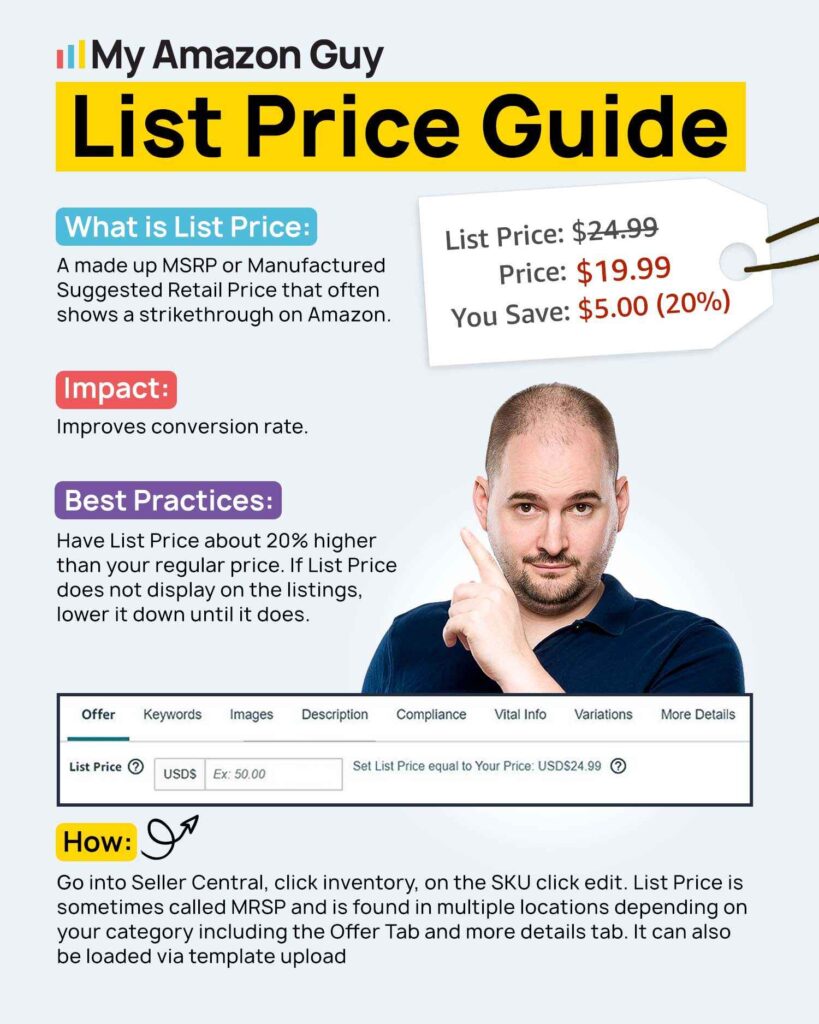
Pricing Strategy To Make New Product Into A Best Seller
Lower the price temporarily: The conversation suggests a significant temporary price drop (up to 50%) to generate initial sales and reviews. This can be risky for profits, but reviews and sales momentum are crucial for long-term success on Amazon.
Gradually raise price: The conversation suggests raising the price in steps after getting a baseline of sales and reviews. This allows you to recoup lost profits from the initial discount.
Invest on Amazon SEO
Spend time, effort, and resources on Amazon SEO to:
- Get Seen: Optimized listings land your product in front of the right eyes, not lost in a sea of also-rans.
- Rank Higher: Target the “sweet spot” keywords for prime real estate on search results pages.
- Boost Sales: Speak directly to your ideal customer’s needs with relevant keywords, leading to more clicks and conversions.
- Outshine the Competition: Stay ahead of the SEO game and watch your product rise above the rest.
- Win the Long Game: Invest in Amazon SEO and unlock sustained success for your business.
Understand the Importance of Amazon Search Engine Optimization
- Indexing and Ranking: Essential for visibility in Amazon search results and driving traffic to listings.
- CTR Optimization: Improve click-through rates with strategic keyword placement.
Utilize AI Tools for Product Copy
- AI Efficiency: Leverage tools like ChatGPT or Bard to craft SEO-focused product descriptions.
- Keyword Integration: Focus on high-frequency keywords for better indexing.
Implement the MAG SEO Phase Process
- Phase 1: Indexing: Use primary keywords in titles and backend search terms.
- Phase 2: Optimization: Adjust search terms and keywords based on performance.
- Phase 3: Ranking: Focus on “Strike Zone” keywords (rank 20-50) to push them higher.
- Phase 4: Analysis: Utilize search query performance reports to refine strategies.
Learn more about our Full Service Amazon Agency’s 4-Phase SEO.
Optimize Your Product Listing
- Titles: Clear and concise titles that describe the product, include the brand name, and highlight key benefits.
- Bullet Points: Answer key customer questions, include warranty and customer service information, and keep them brief.
- Main Image: Follow our marketing agency’s Main Image CTR Hack to include primary keywords in the main image for immediate recognition.
- Secondary Images: Upload secondary images like infographics and lifestyle to show all the features of your product
- Product Description: Use AI-generated content, refine it for accuracy, and ensure it includes relevant keywords.
- A+ Content: Optimize alt text in images and backend keywords for additional indexing.
Update the main image with a clear and eye-catching design that showcases the product. Learn about our winning main image strategy.
Consistency and Compliance
- Regular Updates: Continuously update keywords and product copy to reflect current trends.
- Algorithm Compliance: Ensure all content adheres to Amazon’s guidelines to avoid penalties.
Amazon Marketing Strategy - Promote Your Product
Product promotion is an investment in its discoverability, sales potential, and overall success within the platform. It’s a powerful tool to reach your target audience, build brand recognition, and ultimately turn casual browsers into loyal customers.
Use Amazon Advertising
- PPC Campaigns like Sponsored Product Ads: Target low to moderate-traffic keywords for better ROAS (Return on Ad Spend).
- Monitor ACoS: Continually adjust campaigns to optimize ad performance and manage costs effectively.
- Sponsored Ads: Utilize Sponsored Display Ad and Sponsored Brand campaigns within your budget.
Offer Discounts and Promotions
- Special Deals: Participate in Amazon’s Daily Deals or Prime Day to boost visibility and sales.
- Strategic Discounts: Use discounts early in your product’s lifecycle to gain reviews and relevance.
- Limited-Time Offers: Implement promotions strategically to avoid constant deep discounting.
Utilize Amazon Reviews
- Follow-Up: Send follow-up emails to customers to encourage reviews.
- Automation: Use tools like SageMailer to automate review requests.
- Positive Feedback: Leverage positive reviews to enhance your product’s credibility.
Use Affiliate Marketing
- Amazon Associates Program: Partner with affiliate marketers to promote your products.
- Affiliate Links: Provide affiliates with unique links to advertise on their websites and social media.
- Commission-Based Sales: Offer commissions to affiliates for each sale made through their links.

Utilize Multichannel Marketing For Your Marketing Plan
Multichannel Marketing of Your Products and Services: Why It Works
- Reach More People: Cast a wider net and capture customers across various touchpoints.
- Deeper Engagement: Cater to customer preferences and personalize messages for better interaction.
- Stay Ahead: Adapt to changing behaviors and outshine competitors with a well-rounded strategy.
- Stronger Brand: Create a unified brand experience across all channels, boosting recognition and impact.
- More Conversions: Increase the chances of converting leads by engaging them where they are.
Influencer Marketing
Consistent influencer marketing on the right platform is key to maintaining brand awareness and sales for high-end products.
- Collaborative Endorsements: Partner with influencers to promote products or services.
- Build Credibility: Leverage influencers’ authority to reach their dedicated followers.
- Targeted Audiences: Reach niche markets through influencers aligned with your brand.
User-Generated Content (UGC)
UGC is exploding on social media and brands can leverage it to drive traffic to their Amazon listings, even though attribution links might not work.
- Customer Advocacy: Encourage customers to create content featuring your products.
- Authenticity: Boost trust with genuine user testimonials and experiences.
- Amplified Reach: Multiply content distribution through customer networks and social platforms.
Social Media Marketing
Track brand term searches on Amazon to measure TikTok’s indirect influence on sales, but TikTok Shop itself faces logistical challenges for established businesses.
- Platform Engagement: Utilize platforms like Facebook, Instagram, and LinkedIn to connect with audiences.
- Targeted Advertising: Tailor ads based on demographic, behavioral, and interest-based data.
- Community Building: Foster communities around your brand for ongoing engagement and loyalty.
Use Video Marketing
Level Up Your Multichannel Strategy with Video Marketing on Amazon:
- Grab Attention, Boost Engagement: Videos are eye-catching, keeping viewers hooked and interested in your product.
- Turn Lookers into Buyers: Videos build trust and showcase your product effectively, leading to higher conversion rates.
- Rise in the Rankings: Amazon favors listings with videos, potentially giving you a search engine boost on the platform.
- Crystal Clear Communication: Videos let you visually explain your product, reducing confusion and boosting customer confidence.
Incorporate Video Marketing on Amazon
Product Demos and Tutorials in Digital Marketing
- Showcase Features: Demonstrate how your product works, its benefits, and unique features through video.
- Educational Content: Provide tutorials on product usage, assembly, or maintenance to inform and assist potential buyers.
Customer Testimonials and Reviews
- Build Trust: Share authentic customer reviews and testimonials through video to build credibility and trust.
- Showcase User Experience: Highlight customers using your product, sharing their experiences, and outcomes achieved.
Behind-the-Scenes and Brand Storytelling
- Brand Narrative: Tell your brand’s story, values, and mission through compelling visual storytelling.
- Show Transparency: Offer a glimpse into your company culture, manufacturing process, or product development journey.
FAQs and Customer Support
- Answer Queries: Address common customer questions, concerns, and FAQs through video responses.
- Improve Customer Experience: Enhance customer support by providing clear, visual explanations and troubleshooting tips.
Social Proof and Influencer Collaborations
- Influencer Endorsements: Partner with influencers to create engaging video content endorsing your products.
- Leverage Social Proof: Showcase how influencers incorporate your product into their daily lives or routines.
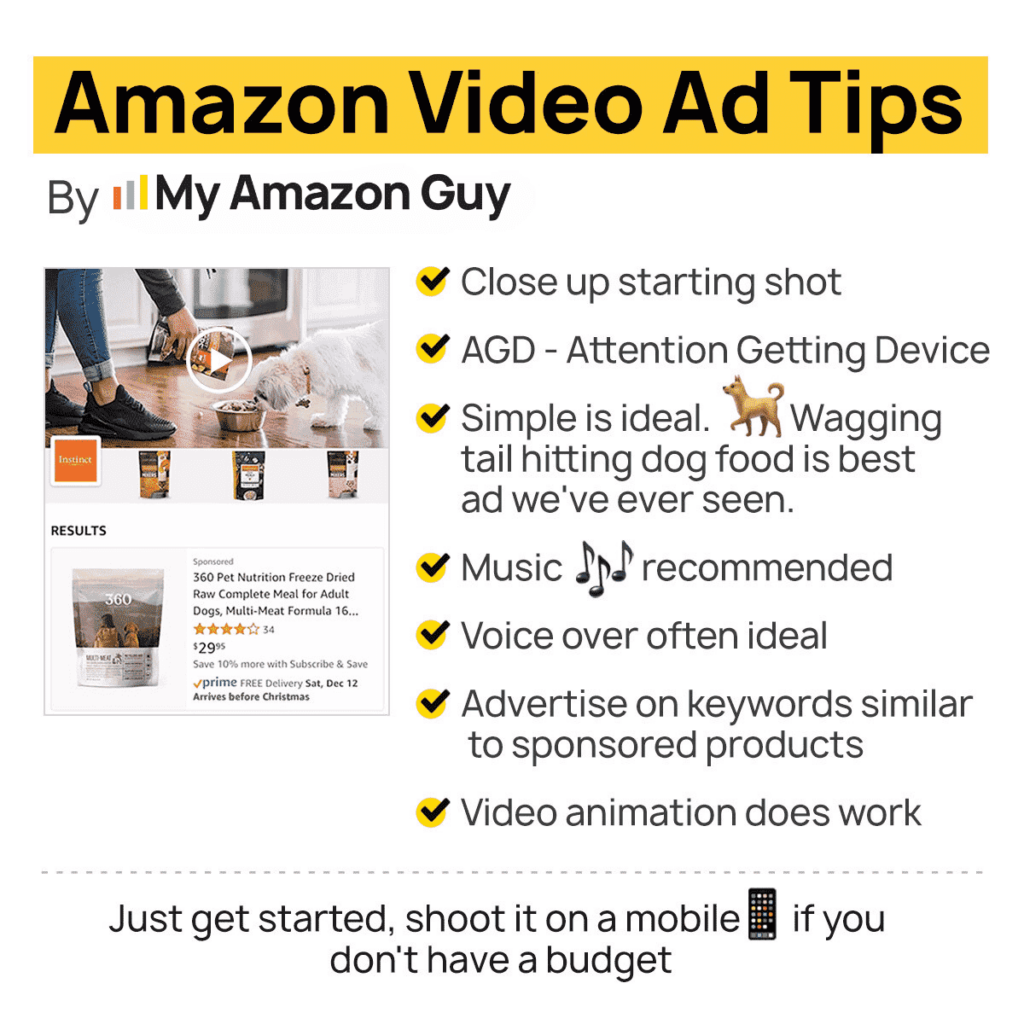
Make Your Videos Shine
- Keep it Short & Sweet: Create clear, concise videos optimized for mobile viewing on Amazon.
- Tell Them What to Do Next: Include a strong call to action, whether it’s visiting your store or making a purchase.
- Stay Fresh: Update videos with new features, positive reviews, or customer testimonials to keep viewers engaged.
Set Up A Dedicated Website
Own Your Brand, Own Your Success:
- Craft Your Image: A website gives you complete control over how you present your brand to the world.
- Deeper Connections: Foster stronger customer relationships through direct engagement on your website.
- Sales Powerhouse: Drive sales with targeted marketing efforts and multiple conversion channels.
- Unlock Customer Insights: Gain valuable data to understand your audience and refine your strategy.
- Stand Out from the Crowd: A dedicated website shows professionalism and sets you apart from the competition.
Tips for Launching a Dedicated Website
Choose the right platform: Select a platform that integrates with Amazon, such as Shopify or WooCommerce.
Keep it simple: Don’t overwhelm customers with too much information. Keep your website design clean and easy to navigate.
Optimize for SEO: Ensure your website is optimized for search engines to improve visibility and drive organic traffic.
Integrate with Amazon: Integrate your website with Amazon to leverage your customer reviews and ratings.
Measure Your Marketing Performance
Measuring your Amazon marketing performance involves tracking various metrics across sales, traffic, conversions, and customer engagement.
By leveraging analytics tools and adopting a data-driven approach, businesses can refine their strategies to maximize ROI and achieve long-term success on the platform.
Key Metrics for Measurement
Sales Metrics
- Total Sales: Monitor overall revenue generated from Amazon sales.
- Sales Growth: Track trends in sales growth over specific periods.
Traffic Metrics
- Sessions: Measure the number of visits to your Amazon product pages.
- Traffic Sources: Identify the origin of your traffic, such as organic search or paid Amazon ads.
Conversion Metrics
- Conversion Rate: Calculate the percentage of visitors who complete a purchase.
- Add-to-Cart Rate: Measure how frequently shoppers add your products to their cart.
Advertising Performance
- ACoS (Advertising Cost of Sales): Assess the efficiency of Amazon PPC campaigns.
- CTR (Click-Through Rate): Evaluate the effectiveness of your ad creative and placement.
Customer Engagement
- Reviews and Ratings: Monitor customer feedback and ratings to gauge satisfaction.
- Question & Answer Activity: Track engagement and responsiveness to customer inquiries.
Tools and Methods for Measurement
- Amazon Seller Central Analytics: Utilize integrated tools for detailed insights into sales, traffic, and customer behavior.
- Google Analytics: Integrate tracking pixels with Amazon to measure external traffic and conversions.
- Third-party Analytics Tools: Employ advanced analytics tools like Helium 10, Jungle Scout, or Sellics for competitor analysis.
Steps to Measure Performance
- Set Clear Objectives: Define specific goals such as sales targets, ROI thresholds, or traffic growth percentages.
- Track KPIs Regularly: Monitor performance metrics daily, weekly, and monthly to identify trends and anomalies.
- Compare Against Benchmarks: Benchmark your performance against industry standards and previous periods for performance evaluation.
- Optimize Based on Insights: Use data-driven insights to refine marketing strategies, adjust ad campaigns, and optimize product listings.
- Report and Iterate: Generate comprehensive reports to share with stakeholders, learn from outcomes, and continually refine strategies for ongoing improvement.
Amazon Marketing: Because Wishing for Sales Isn't a Strategy
With the ever-evolving landscape of Amazon marketing, it’s essential to stay ahead of the game by implementing a comprehensive Amazon marketing strategy for 2024 and beyond that drives sales, builds brand awareness, and establishes credibility.
By following the steps outlined in this article, you’ll be well on your way to creating a strong Amazon marketing campaign that sets you apart from the competition. Remember, wishing for sales won’t cut it – it’s time to take action and make your Amazon marketing strategy a reality.
Don’t leave your success to chance. Whether you’re launching a new product on Amazon, seeking to optimize existing listings or need an Amazon marketing strategy, our expert team at My Amazon Guy is here to help.
We specialize in delivering tailored strategies that drive visibility, engagement, and sales on Amazon.
Ready to take your Amazon business to the next level? Contact us today for a consultation and discover how our proven methods can transform your sales trajectory.
Start building your winning Amazon marketing strategy now!




